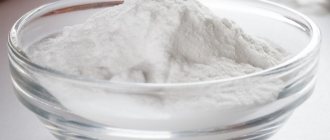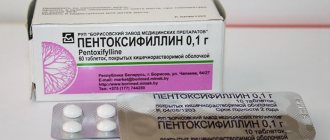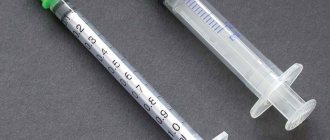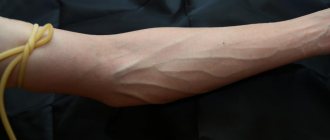For what reasons can a lump appear on a vein?
A lump on a vein was formed due to some kind of stagnation inside the vessel. The reason for this may be mechanical impact, varicose veins or the development of thrombophlebitis.
These formations at the initial, harmless stage are easily crushed by palpation, but their hardening indicates the beginning of the formation of a blood clot.
Thrombophlebitis is a deadly disease, as the blood clot can break off or rupture the walls of the vein.
Causes
The formation of a seal on a vein indicates that there is a blood clot inside the vessel; it can form as a result of the development of a disease or disruption of the membrane during medical procedures: an IV, placing a catheter, or a lump may appear on the vein after blood sampling. Possible reasons for the formation of a blood clot inside a vein:
- lack of physical activity, sedentary work;
- heredity, varicose veins, thrombophlebitis;
- presence of excess body weight;
- wearing tight-fitting clothing;
- injuries;
- constantly wearing heels;
- taking oral contraceptives and other hormonal drugs;
- infectious blood infections.
Important!
A separate point is mechanical causes, when a lump forms on a vein after a catheter or injection, this phenomenon is called cubital phlebitis.
The appearance of a pronounced ball or lump on a vein indicates a progressive process of varicose veins. Many patients are negligent about these symptoms and consult a doctor in the later stages of the disease.
For easy and effective treatment, it is important to notice the problem in time and contact a specialist. Other causes of a blood clot:
- progressive vascular atherosclerosis;
- wrong lifestyle;
- presence of bad habits;
- poor nutrition.
The primary symptoms of varicose veins are heaviness in the legs, constant fatigue, tingling in the veins, burning sensation, swelling of blood vessels. At this stage, it is already necessary to begin treatment without waiting for bumps to appear.
Possible treatment
If a lump grows on a vein after an injection or placement of an IV, then the treatment can be done with the use of ointments - venotonics, containing heparin. A tight elastic bandage is applied on top of the formation. It is recommended to move your arms more often, and you may need to take blood thinning medications.
Consultation with a phlebologist
The main stage in treatment and diagnosis is contacting a competent specialist - a phlebologist; if there are no such doctors in the city, then you need to go to a neurologist. Consulting a doctor about the presence of a blood clot in a vein requires a scrupulous approach to examining the patient:
- the doctor must collect a detailed medical history: find out everything about the patient’s lifestyle, hereditary factors, what the person eats, the presence of bad habits;
- It is better to go to the doctor with the collected results of tests that were done previously, if any;
- Next, the phlebologist will conduct it himself or refer the patient to an ultrasound of the vessels of the whole body, this is necessary in order to exclude the presence of blood clots in the deep veins.
A thorough examination of the patient is the key to successful treatment.
Classical drug therapy
Classical therapy includes a whole range of measures: drug treatment, lifestyle adjustments, giving up bad habits, diet. Small, soft formations are treated with drugs - venotonics, which include: Detralex, Troxevasin, Troxerutin.
Ointments do not help with severe problems with the veins; they can only have a temporary effect of relieving heaviness in the legs, but will not affect the resorption of the blood clot.
If, during the examination, blood clots are detected in the deep veins, the patient is placed on strict bed rest and intravenous infusions of absorbable drugs, while both legs must be tightly wrapped with an elastic bandage.
In parallel with taking venotonics, the patient needs to wear compression garments (stockings or knee socks), rest more, and breathe fresh air. It is important to adjust your diet by removing fatty foods, fried foods, fast food, alcohol, and quit smoking.
Radical methods
Radical methods of treating blood clots in the veins include:
- laser treatment of damaged and stretched areas of blood vessels;
- surgical removal;
- sclerotherapy.
These techniques are used for advanced cases of varicose veins, atherosclerosis and thrombophlebitis.
If you consult a doctor in time, you can avoid debilitating procedures and limit yourself to traditional therapy.
In such cases, it is better not to resort to self-treatment or the use of traditional medicine; such treatment can bring many complications, including disability and death.
Varicose veins
Varicose veins (a simplified name for varicose veins) is a pathological process that leads to damage to the veins.
With this disease, so-called nodes are formed, which are aneurysal-like (similar to an aneurysm - protrusion of the walls of the arteries due to their thinning) local expansions.
Varicose veins are characterized by an increase in the diameter of the lumen and thinning of the venous wall itself.
Varicose veins most often affect the vessels of the legs, but sometimes manifests itself in other organs. Since the arms are constantly exposed to stress and, in addition, are most often lowered, the blood flow to them is increased. This gradually leads to stagnation. Initially, the appearance of dilated veins occurs on the hands. Due to the appearance of such a symptom, it is recommended to consult a specialist, since bloating of the veins is possible not only with varicose veins, but also with other pathologies.
Sometimes the disease is accompanied by painful sensations. This occurs due to impaired functioning of the vascular valves. Violation of their performance leads to an increase in blood pressure, as a result of which, in turn, the vessels begin to twist. It is this process that can cause severe pain. Therefore, you should not wait for the disease to develop, because at the initial stage it is much easier to treat.
Self-treatment for such diseases is not recommended, as this can lead to bad consequences. And an experienced specialist will choose an effective and correct method of treatment. Sometimes surgery may be required, the details of which will be discussed with your doctor.
It should be noted that there is an opinion that varicose veins of the arms do not exist in nature. However, thinned and bulging veins do occur on the upper extremities.
They took blood from a vein and a lump formed
Surgeon, Candidate of Medical Sciences, Associate Professor of the Department of Surgical Diseases and Clinical Angiology, Moscow State Medical University named after. A.I. Evdokimov.
Has thematic improvements in oncology, thoracic surgery, vascular surgery, laparoscopic and robotic surgery
Area of professional interests: general surgery, laparoscopic and open interventions on the abdominal organs, for tumors of the gastrointestinal tract.
Surgical treatment for acute and chronic diseases of the gastrointestinal tract (cholecystitis, hiatal hernia, complications of peptic ulcer of the stomach and duodenum, tumors of the stomach, small and large intestine, reconstructive surgery on the colon) hernia of the anterior abdominal wall (umbilical, inguinal, postoperative), removal of skin and subcutaneous tissue tumors.
Telephone for consultation.
A site for moms, dads and kids!
Online store Photo gallery News blog
Forum 2004-2008 Consultations of specialists
- Unanswered messages
- Active topics
- Search
- BookmarksSubscriptions
- Photo gallery, News. blog, Expert Consultations Forum 2004-2008
Why did the lump appear and how to treat it
Sometimes lumps form at the site of the vein puncture, and the arm begins to hurt. This happens due to a specific reaction to damage to the vein. If such a problem occurs, then you need to consult a doctor. Perhaps he will refer you for an ultrasound examination to check the condition of the blood vessels. But most likely it is not dangerous.
If a hematoma forms along with the lump, this means that after donating blood, some amount of blood got under the skin. The bruise can be either small or large. Whether you should be wary of such a manifestation can be checked using several points:
- the lump is felt to the touch, but does not hurt;
- there is no redness at the injection site;
- no increase in temperature is felt at the injection site.
Typically, these lumps dissolve within a few days, depending on the size.
But if your arm hurts, the temperature at the injection site or body temperature rises, or there is redness and swelling at the puncture site, then you need to contact a specialist. This may be the start of an infection.
The appearance of a hematoma (bruise) at the site of a needle puncture during collection of venous blood or an intravenous injection occurs infrequently these days. However, many patients are familiar with this situation firsthand.
Individual characteristics of the body play an important role in the appearance of a hematoma and even subsequent pain in the puncture area.
But the veins in the arms can also hurt due to more serious pathological changes in the body.
There are general rules on how to donate blood from a vein, which should be strictly followed.
The blood test is performed in the morning, usually between 8:00 am and 11:00 am, on an empty stomach. The day before and in the evening, you should not eat unusual foods for yourself, new dishes, salty, spicy or fatty foods. Alcoholic beverages are also excluded.
Before donating blood from a vein, it is not allowed to undergo instrumental examinations or use physiotherapeutic therapy.
If you are taking certain medications, you should discuss them with your doctor, who will advise you on whether you can take the medication before the tests or whether it is best to abstain for now.
Before the procedure, you should also not smoke (2 hours before), try to avoid stressful situations and physical activity.
If a repeat analysis is necessary, the conditions for donating blood must be the same as the first collection of biological material. This is necessary in order to obtain results of equal accuracy. In other words, you must also follow all the rules for preparing for the procedure and the doctor’s recommendations.
Many parents are concerned about the question of how and why to donate blood from a vein to their children.
These studies are necessary in order to avoid the development of various pathologies in newborns:
- Allergens are identified. It's no secret that today newborn children already have allergens in their bodies, which in the future can cause a lot of trouble for children and change their quality of life for the worse.
- Detection of parasitic and viral infections. To do this, serological tests are carried out to exclude the presence or confirm the diagnosis of mumps, toxoplasmosis, amebiasis, herpes, and to identify the presence of a harmful parasite and other blood diseases.
- The blood sugar level is also determined, which will determine the baby’s predisposition to diabetes or exclude this diagnosis.
- Find out the blood type of the newborn.
Collecting biomaterial from children has its own characteristics, just like donating blood. To do this, blood is taken from a vein located on the head, on the forearm, on the back of the palm and in the area of the elbow. It is in these places that children can easily see and feel veins, which makes the task of inserting a needle into a vein easier.
Why your hands may hurt
Pain in the arms often forces people to seek help from a rheumatologist or orthopedic traumatologist. The hands are quite a delicate mechanism, they have to perform many functions, and pain becomes an obstacle to this, it can be aching, sharp, throbbing. Some diseases can deprive the upper limbs of mobility, causing discomfort.
Pain is a symptom that accompanies many diseases; by determining its nature, it is possible to establish the type of pathology.
A specialist should deal with this issue, but the patient is also advised to remember what events preceded the onset of pain. Pathological sensations can be traumatic and non-traumatic.
Reasons that may cause their appearance include:
- Rheumatoid arthritis. An autoimmune disease in which joints are destroyed and an inflammatory process develops. Pathology can be diagnosed in people of different ages. A characteristic feature of the pathology is the symmetry of the lesion. Over time, joint deformities, curvature of fingers and limited mobility appear.
- Gout. Formation provokes the accumulation of excess uric acid in the body. It is diagnosed more often in people who abuse meat products and dishes. There is severe pain, the intensity of which increases at night. Gouty bumps form around the affected area.
- Osteoarthritis. The main reason for its occurrence is wear and tear of the articular cartilage. More often diagnosed in older people. It manifests itself as pain first in the small joints of the hands, and then in the elbows and shoulders, which intensify when performing loads.
- Arthritis in acute or chronic form. Its formation is provoked by pathogens of infectious diseases that cause the development of the inflammatory process.
- Injuries (dislocations, sprains, ligament ruptures and fractures). The intensity of the pain will depend on the traumatic injury.
- Cervical osteochondrosis, intervertebral hernia. Leads to pinching of the nerve that is responsible for the innervation of the hands.
- Inflammatory process in the tendon and elbow joint (tendinitis, spondylitis, epicondylitis).
- Bursitis is an inflammation of the periarticular bursa. Characterized by swelling and hyperemia of the skin.
- Vitamin B12 deficiency. This vitamin is responsible for the functioning of nerve fibers and their condition; insufficient amounts of it lead to a feeling of numbness and weakness.
- Drinking excessive amounts of alcoholic beverages on a regular basis. Alcohol negatively affects the condition of nerve fibers and the body, it interferes with the absorption of nutrients.
- Myalgia. Characterized by pain in muscle fibers. Provoking factors: hypothermia, colds, prolonged stay in the same position, excessive physical activity, stress. The pathology can be diagnosed by aching pain, the intensity of which increases when the limbs are lifted upward.
- Impaired functioning of internal organs. The shoulder joint has many nerve endings that are in one way or another connected to the internal organs. Pain from the middle radiates to the shoulder; more often, such reflected sensations are associated with angina pectoris, myocardial infarction, pneumonia, liver disease, neoplasms of internal organs, and internal bleeding.
- Oncology. The neoplasm is diagnosed more often in the tissues of the bones and muscles of the wrists. Myeloma is a disease that is accompanied by the replacement of healthy bone tissue affected by malignant cells. This leads to brittle bones, poor posture, decreased immunity, which entails increased susceptibility to infections.
- Vascular atherosclerosis of the upper extremities. It is characterized by the formation of a blood clot in large vessels of the arms, which leads to blockage or narrowing of their lumen, and the development of tissue ischemia, provoked by oxygen starvation, is observed. Very severe pain appears at the location of the pathology.
Other causes of pain:
- pinching of the median nerve, impaired blood circulation in the tissues, a feeling of numbness, coldness;
- damage: fracture, dislocation, sprain, micro-tears of ligaments caused by excessive stress on muscle fibers (during training without preparation);
- diseases of the spine;
- deficiency of enzymes that ensure the normal functioning of muscle fibers;
- diseases of infectious origin and their complications;
- diabetes;
- poisoning with alcoholic beverages, lead;
- myositis is provoked by helminth infections, their development is more often observed with trichinosis, cysticercosis and toxoplasmosis;
- the effects of stress over time;
- overwork;
- hormonal imbalance.
Regardless of the situation, only a doctor can determine the exact cause of the problem; it is recommended to strictly follow his instructions. You should seek medical help if acute throbbing pain does not disappear after taking medications and is accompanied by swelling and an increase in body temperature.
What to do if a lump forms after taking blood from a vein
Sometimes it happens that after taking blood from a vein, a lump forms. This phenomenon is very unpleasant and causes a lot of inconvenience not only of an aesthetic, but also a physical nature.
Such cases usually happen when you find yourself with an inexperienced nurse. When a bruise forms on the arm, it looks visually unpleasant, but in the vast majority of cases it does not pose any danger.
For what reasons did lumps form after taking blood from a vein? And there are not many reasons.
- During blood sampling, a double puncture of the vein occurred, and after the needle was removed from it, blood began to flow into nearby tissues. As a result, a hematoma forms. In the procedure for taking blood from a vein, their visibility, location near the surface or deep, and, of course, the experience of the staff play a big role. An important role is played by the thickness of the vein, its location and general condition. So, if the vein is deep and has a thin structure, then it becomes much more difficult to get into it with a needle. Such physiological features increase the likelihood that a bruise may appear on the vein after blood is taken.
- After donating blood, the patient is given a cotton swab soaked in alcohol. You need to apply it to the puncture site and bend your arm at the elbow. The hand should remain in this position for about 5 minutes. If the patient straightens it earlier and removes the tampon, then the blood does not have time to stop, flows into the tissue and forms a bruise. Each person's blood clotting rate is different. And therefore, for some, holding the cotton wool for 5 minutes may not be enough; in this case, to avoid a bruise, you need to hold the tampon longer.
Rules for donating blood from a vein
Taking blood from a vein for analysis is the most common and simplest method.
It allows you to quickly and practically painlessly take blood from a patient, and based on the results of its examination, draw conclusions about the state of health and the presence of diseases in a person. There are a lot of blood tests.
A general analysis is often performed, which reflects common indicators such as hemoglobin, the number of red blood cells, platelets and other blood elements.
Blood from a vein is taken for the following tests:
- the presence of infections such as HIV, syphilis, sexually transmitted infections and so on;
- pathology of the liver and kidneys;
- for the control of chronic diseases;
- general analysis, which determines the level of hemoglobin and cholesterol;
- for sugar.
There are also specific tests, for example, for blood type, viruses, the presence of antibodies and others. Doctors have long developed certain rules for donating blood from a vein. Thanks to their precise implementation, the results will be objective and complete. Few people know that it is not recommended to take blood from a vein after an ultrasound examination and x-ray.
For a biochemical analysis, preparation is required, but for an analysis of antibody titer, for example, no preparation is needed. In any case, when prescribing a certain blood test, the doctor will warn you whether you need to prepare for the test and how to do it. Preparation usually consists of taking tests on an empty stomach.
In most cases, the vein located on the forearm is selected. This choice is based on the fact that the skin in this area is thinner and the veins are better visible. The patient must prepare before the procedure.
For some studies, you cannot eat, exercise, drink alcohol or smoke. Many people are interested in how much blood is required for analysis.
The average amount of blood taken from a patient's vein is approximately 10 ml of blood.
Blood is drawn with the patient in a sitting position. A tourniquet is tightened on your hand; first, you may be asked to clench and unclench your fist several times. This is done so that the vein fills with blood and becomes better visible.
Then the laboratory assistant treats the puncture site with a solution. After this, he inserts the needle into the vein and removes the tourniquet, while the fingers should be clenched into a fist. When the laboratory technician draws blood, the fist must be unclenched. Blood is taken slowly so that the patient does not become ill from a sharp decrease in its amount. Blood is collected into special removable tubes.
This is very convenient, since sometimes several blood samples are needed.
After the needle is removed, a cotton swab soaked in the solution is applied to the puncture site. After this, you need to quickly bend your arm at the elbow, this will help stop the bleeding. If you hold it poorly, a bruise will form.
The laboratory technician who performs the blood collection procedure must wear gloves.
Please ensure that the needle comes from a new individual package. Of course, cases of negligence and disregard for sterility rules are very rare, but it is still worth monitoring their implementation. Sometimes, if several blood samples need to be taken, this may affect the patient's well-being. Dizziness occurs, fever occurs, and general weakness appears.
If such symptoms appear, then simply sitting for a while or eating something sweet, such as chocolate, is enough.
How to treat the ailment that has arisen
If a bruise appears on a vein after donating blood, the following measures can be taken to eliminate it.
- Alcohol compresses help a lot. They help the bruise on the vein resolve.
- You can apply an iodine mesh or brilliant green to the vein. Although this option is not the most suitable, since the hand in this place is very sensitive, and these products have a drying effect.
- There are special ointments for bruises that can be purchased at the pharmacy. Their action is based on relieving inflammation of the skin and improving blood circulation in the damaged area. Almost all of them are heparin-based. They can be applied up to 3 times a day.
- Venotonic gels. These are decongestants that are used for venous circulation disorders. They reduce the fragility of capillaries, increase the strength of vessel walls, and improve microcirculation in the vein.
- Taking ascorbic acid helps resolve bruises and improves immunity.
- A simple and effective remedy for a bruise is an ice compress wrapped in a cloth. You need to apply it for 20 minutes and then the bruise will go away faster.
All these methods are very simple and accessible. They have no contraindications. On the other hand, they are not required to be used, since the bruise that appears will go away on its own in a few days.
Preventing bruises
To prevent a bruise on a vein from appearing, you need to follow a few simple rules.
- Monitor the condition of your blood vessels. Healthy vessels recover faster after damage, and thereby increase the likelihood that a hematoma will not form.
- After drawing blood, hold the swab with the solution longer. There is no need to rush to remove it; it is better to sit for a few minutes so that a bruise does not appear, than to later deal with the consequences of your haste.
- People who develop bruises after donating blood usually have thin and hard-to-see veins. In order to reduce the risk of bruising, you need to choose the most visible vein for analysis, from which it will be convenient to take blood.
If you follow these simple rules, a bruise may not appear, and you will get rid of unpleasant consequences and the need to use additional treatment measures.
Recommendations
In order to avoid a bruise on the arm after the injection, the following rules must be followed:
- During the clinical test, you need to sit quietly;
- After taking a clinical analysis, a cotton swab soaked in an alcohol solution must be applied to the place where the blood was taken;
- The cotton wool should be kept for 15 minutes. During this time, the blood in the puncture on the arm will cease to flow;
- It is not recommended to lift heavy objects with the hand from which the test was taken for half an hour after the laboratory procedure.
If after some time the pain in the arm at the puncture site does not go away and the discomfort is accompanied by additional symptoms, then the person needs to seek medical help. After examining the sore spot, a medical specialist will be able to understand the cause of the discomfort in the hand and prescribe therapeutic measures that will help get rid of the symptoms. If you follow your doctor's recommendations, you can reduce the risk of additional symptoms after taking a biochemical test.
What to do if a large bruise forms after taking blood from a vein
Immediately after formation, the hematoma has a rich purple color. The stain that forms on the hand can be huge or small. A bruise after taking blood from a vein can appear for various reasons. If no complications occur, then after 1-2 weeks the mark will disappear. As the bruise dissolves, it will change color.
What does the appearance of a hematoma mean?
When blood is taken from a patient's vein or an intravenous injection is given, a blood vessel is punctured.
From the hole formed by the needle, biological fluid can exit into the intercellular space and fill (wet) the subcutaneous tissue. The size of the bruise will depend on how much blood comes out of the injured vein.
Why does a bruise appear?
A bruise after taking blood from a vein, the cause of which most patients consider the lack of qualifications of the medical worker, can form during the collection of biological fluid, as well as after all manipulations or the next day. Medical error is not excluded from the possible factors contributing to the formation of a hematoma, but there are other sources of the problem.
Bruises from injections into a vein or after donating blood can appear due to:
- poor clotting;
- frequent manipulation of the same vein (repeated testing or injection of drugs);
- high venous pressure;
- thinning of vascular walls;
- low quality medical instruments (dull needles);
- simultaneous puncture of the anterior and posterior walls of the vein;
- non-compliance with medical recommendations during vein manipulation;
- untimely removal of the tourniquet;
- the patient's use of medications that thin the blood;
- premature extension of the joint after drawing blood from a vein or injection.
After visiting the manipulation room, not only bruises, but also bumps may appear.
In most cases, they are formed as a result of the drug that was administered to the patient entering the subcutaneous space.
Other reasons include:
- introduction of oil-based drugs;
- non-compliance with sanitary standards;
- frequent placement of catheters;
- non-compliance with the rules for the speed of drug administration;
- individual specific reaction to vein damage, etc.
How to avoid a bruise
Immediately after the needle is healed, you need to bend the joint and do not straighten it for about 5-10 minutes.
For the remaining 24 hours, it is not recommended to physically overload your arm.
What to do
When it was not possible to avoid the appearance of a hematoma, cold will help prevent its increase. It should be applied to the problem area for several minutes. Ice or a cold heating pad will cool the injured area, which will help reduce the rate of blood flow and prevent an increase in subcutaneous hemorrhage.
What do you think are the most important factors when choosing a medical facility?
- Trust in the doctor 71%, 225 225 – 71% of all
- Modern equipment 16%, 50 50 – 16% of all
- Close location to home 4%, 13 13 – 4% of all
- Cost of services 4%, 12 12 – 4% of all
- Advice from friends 3%, 10 10 – 3% of all
- 5 – 2% of all
This technique is effective when the bruise is just beginning to form.
Compresses
A bruise that appears on the body after an injection (or taking blood) will not disappear immediately, but you can speed up the process of its resorption. A water-alcohol compress has a good therapeutic effect. A piece of gauze should be moistened in vodka (alcohol can be diluted with water 1:1), applied to the site of the hematoma and secured with cling film. The compress can be left overnight.
Demixid will help remove traces left after medical procedures. The drug must be mixed with boiled chilled water in a ratio of 1:4. A piece of gauze is moistened in the resulting solution, applied to the bruise, wrapped in film and left for 7-8 hours.
Ointments and other medications
In addition to compresses, you can use special ointments that will promote the process of resorption of hemorrhage. Hematoma from an injection can be cured with Heparin ointment. The following drugs have also proven themselves to be effective:
- Bruise-off;
- Troxevasin;
- Girudoven;
- Bodyaga;
- Indovazin;
- Rescuer;
- Arnigel;
- Troxerutin and others.
Gel or ointment for bruises after injections should be used according to the instructions, after making sure that there are no contraindications.
Traditional methods of treatment
Traditional medicine will also help get rid of traces of hemorrhage. An affordable and effective remedy is to treat hematomas with soda. In 1 glass of water you need to dissolve 1 tbsp. powder, moisten a piece of bandage in the resulting liquid and apply to the bruise. Cover the top with cling film and leave for 1 hour. The procedure is repeated 2 times a day.
Onions can also help deal with marks after injections or blood drawing.
The vegetable is grated and applied to the hematoma for 40-60 minutes.
To treat bruises, you can prepare a compress from a mixture of sour cream, red and white clay. Apply the resulting mixture to the problem area and leave until completely dry. This compress can be done overnight. To do this, you will need to cover the homemade ointment with a plastic bag and secure it with a bandage.
Starch can be applied to the bruise several times a day. You need to add water to it to get the consistency of thick sour cream. The resulting mass is applied to the hematoma and left for 30 minutes.
Possible complications and their prevention
If a patient has an intravenous drip placed on his arm, an injection is given, or blood is drawn, in addition to a bruise, he may experience the following complications:
- Phlebitis. Inflammation of the vein wall can be caused by damage to it or an allergy to the injected drug. Signs of pathology are redness in the puncture area, pain and increased local temperature. Treatment is carried out on an outpatient basis.
- Thrombophlebitis. Inflammation of the vein wall with the formation of a blood clot. The patient begins to complain of pain in his arm. The limb may swell. A compaction forms in the area of the thrombus. Treatment is selected depending on the severity of the pathology. Therefore, in addition to ointments, compresses and tablets, the patient may be recommended to undergo surgery.
- Thromboembolism. Impaired blood flow, leading to discoloration of the limb, swelling and loss of sensation. This complication is dangerous due to the development of gangrene. Hospitalization required.
- Abscess. If an infection gets into the wound, purulent inflammation of the tissue may begin. A lump forms in the area where the needle was inserted. If it is soft, then pus has accumulated in it. The patient is prescribed antibacterial therapy. Surgical cleaning may be performed. If necrotic tissue has formed, it is excised.
- Phlegmon. Diffuse purulent inflammation of tissues that does not have clear boundaries. General signs of intoxication are observed. A hard lump is formed, which gradually becomes soft. In most cases, treatment is performed surgically.
To prevent a lump or bruise from forming after taking blood from a vein, you must follow all medical recommendations (before the procedure, during it and after).
Until complete healing, you need to keep the puncture site clean. To avoid complications, the patient is advised not to hide anything from the doctor.
If your arm hurts during medical procedures, you should immediately inform your healthcare provider.
What does the appearance of a hematoma mean?
When blood is taken from a patient's vein or an intravenous injection is given, a blood vessel is punctured.
From the hole formed by the needle, biological fluid can exit into the intercellular space and fill (wet) the subcutaneous tissue. The size of the bruise will depend on how much blood comes out of the injured vein.
Bruise after taking blood from a vein and from a finger - causes and treatment methods
Drawing blood is a standard procedure. For various studies, the contents of the veins or capillaries of the finger may be needed. In a healthy person, if the technique is followed, this manipulation does not cause pain. The appearance of a bruise after taking blood from a vein or from a finger may indicate the individual characteristics of the patient or the incorrect procedure.
Taking blood from a vein
Donating blood from a vein is a manipulation to which all patients react differently. If the veins are large, well filled with blood and located close to the skin, a hematoma should not remain during a one-time blood donation. The procedure is carried out using a disposable syringe or a closed vacuum system.
In order to obtain blood for analysis, it is necessary to prick the skin and the wall of the vessel, and then draw a small amount of liquid. When the needle leaves the vein, there is also a risk of its contents getting under the skin and causing a hematoma. To do this, the injection site is tightly clamped with a piece of cotton wool, and the arm is bent at the elbow to slow down blood circulation.
A small blood clot appears in the puncture site of the vessel wall, and the liquid does not flow out.
There are several reasons why lumps may appear after venous blood is taken:
- the vessels are thin, their walls are fragile - this may be an individual feature or associated with certain diseases;
- the veins are located deep under the skin - during manipulation it is necessary to injure small subcutaneous capillaries, and then it is not possible to firmly clamp the puncture site;
- blood clotting disorders - a blood clot forms slowly, and the contents continue to leak from the puncture site for a long time;
- dehydration of the body - in this case there is little fluid in the veins, blood pressure decreases;
- non-compliance with the recommendations of medical staff.
The arm should be kept bent at the elbow for at least 10 minutes.
The likelihood of bruising the vein increases if this procedure has to be performed several times. The walls of blood vessels become thin and restore integrity more slowly. In such cases, they try to alternate the hand for donating blood, but the lump may still remain.
If a bruise has already formed, there are several ways to get rid of it. The simplest method is to apply ice to the hematoma.
It can also be used to prevent the appearance of a lump - the cold constricts blood vessels and slows down blood circulation. Pharmacies have a huge selection of ointments for resolving bruises.
You can choose products based on heparin (Heparin ointment, Lyoton), badyagi, as well as any other drug recommended by a doctor, for example Troquevazin.
Taking blood from a finger
Taking blood from a finger prick from a healthy person is a common diagnostic procedure. Indicators may be needed both for routine examination and to make sure how to treat certain diseases. After the manipulation, the finger does not hurt, and the puncture site is not visible after a few hours.
However, in some cases, a bruise may form on the finger. In order to collect material for research from small capillaries, you need to puncture the skin and squeeze the tissue so that the liquid flows into the test tube.
If a hematoma forms on the finger after blood sampling, this may indicate one of the following factors:
- capillaries are located deep in the tissue and are difficult to puncture;
- the fluid pressure in the vessels is insufficient, and during the procedure you have to squeeze your finger hard;
- blood clotting indicators are reduced - it flows out for a long time after the procedure.
If a bruise appears, this is not a cause for concern. This often occurs in children and the elderly, as well as in patients with sensitive skin. However, there are ways to remove a bruise at home. These can be cold compresses or heparin-based ointments.
Alcohol rubbing or lotions containing arnica or horse chestnut extract are also useful.
You can make iodine mesh on your finger - it is not recommended to remove a bruise after drawing blood from a vein in this way, since the skin of the forearm is thin and more sensitive.
Even if a bruise forms after any method of taking fluid for analysis, it should completely disappear within a few days without treatment. You should try not to strain your hand, otherwise the blood clot may be injured and the bleeding will resume.
If the hematoma does not resolve within a week, you should consult a doctor.
After taking blood for analysis by any method, some patients complain of the appearance of a hematoma or lump. It is normal for the swelling to go away the next day or within a few days.
Its formation may be associated with the individual characteristics of the patient, certain diseases, or a violation of the technique of the procedure.
To prevent this, you should listen to your doctor’s recommendations, properly prepare for the manipulation, and after it, wait enough time before straightening your arm at the elbow and removing the cotton swab.
How should you take blood from a vein?
Actions in case of complications
The manipulation is left behind, you are already at home, you have practically forgotten about the doctors and syringes, when suddenly you notice a dark spot on your arm. What should I do, should I worry about this?
First aid
If something goes wrong during the injection or taking tests, a hematoma occurs or a muscle hurts, the first thing you need to do is apply ice to it. This will stop further spread of blood under the skin and relieve pain. Cool the puncture site moderately, avoiding numbness. In the first two days this can be repeated several times. Next, the hematoma area should be warmed moderately.
It is advisable to use Heparin ointment or Troxevasin, local anesthetics. Before applying any medicinal creams to the hematoma area, you should smear it on a small healthy area of skin and make sure that they do not cause allergies. You can apply an iodine mesh to the bend of the elbow, but in no case do not smear this area completely and do not apply a cotton sponge soaked in iodine - this can cause a burn.
First aid is relevant during the first hours after the procedure. If your hand begins to bother you later, you should consult a doctor.
Radical measures
Varicose veins and thrombosis are diagnosed by a phlebologist and surgeon. An ultrasound and external examination are performed, and appropriate treatment is prescribed. When bleeding during varicose veins, the main thing is to stop the bleeding. A tight bandage is applied, but not a tourniquet, which can severely injure fragile vessels, the arm is raised up until the bleeding stops.
For thrombophlebitis, if the vein hardens after an injury and the arm swells, the doctor prescribes therapy. These can be compresses with magnesia, Lyoton or other ointments.
Both of these diseases are treated regardless of how often you have to donate blood. Pathologies create problems and are dangerous in themselves; precautions cannot be neglected. As a rule, patients take a course of drugs that strengthen the walls of blood vessels, external or internal venotonics, and bandage the affected limbs. Surgery is often necessary.
When piercing, it is especially important to follow the rules of hygiene and avoid contamination. It is possible that an infection may enter the wound, leading to subsequent infection.
If the injection site of the needle continues to bother you, the hematoma does not go away well or the bruise has formed after chemotherapy, your arm hurts very much after an injection into a vein, your arm becomes numb and your temperature rises, you should urgently consult a therapist who will determine exactly why this is happening and prescribe treatment.
A vein was pierced when drawing blood, what should I do?
- What to do if a vein bursts after donating blood
- How to cure a bruise after an IV
- How to take blood from a finger
What are the risks of taking blood from a vein?
The first time you encounter a problem after donating blood, you should not panic. You can seek advice from doctors or try traditional medicine recipes.
What ointments resolve bruises
You can buy ointment at the pharmacy - “Troxevasin”. It restores veins and resolves bruises. Heparin and butodionic ointments have a similar effect.
They can be mixed before use and spread in a thin layer on sore spots 4 times a day; compresses are not recommended. Heparin ointment costs about 40 rubles, so it makes no sense to buy expensive analogues.
Cold lotions or ice will help relieve severe swelling.
Compresses and prophylaxis for veins
You can make vodka compresses. It is necessary to moisten the bandage with vodka, apply it to the sore spot, and leave for 30 minutes. After this, remove the compress and anoint the bruise with heparin ointment.
Still damaged areas are wrapped with an elastic bandage.
If a person knows that he has bad veins and it is difficult to take blood from them, then the first aid kit should always contain ointments that have venoprotective properties, that is, those that make the veins elastic.
In some people, the vein is almost invisible, so when collecting blood it is difficult to get to the right place the first time. You have to insert the needle several times, hence the disastrous result. Also, after donating blood, patients quickly straighten their arm, which is impossible to do, the blood has not yet had time to clot and begins to spread under the skin.
You can hide noticeable bruises at the site of a vein puncture under long sleeves. No one would even guess about such a temporary defect. This is especially important for the fair sex.
A bruise, as a rule, does not appear immediately, but after a couple of hours or even days. You can draw an iodine grid on the sore spot. To do this you will need iodine and a cotton swab. Sometimes a lump forms at the puncture site. It's a blood clot. Therefore, in order to avoid the occurrence of a blood clot, it is necessary to take immediate action if a bruise appears at the site of blood collection.
If pain and hematoma do not go away for a long time, then you need to contact a surgeon to find out the cause of what is happening.
Taking blood from a vein is a popular medical procedure. Blood tests are informative for many diseases, and even for a preventive medical examination you may need this test. Often a bruise may appear after drawing blood from a vein .
Photo 1. Bruises after blood collection may appear due to incorrect actions of the doctor or patient. Source: Flickr (Kate Prescesky)
What does a bruise mean?
A hematoma after blood sampling means that blood from the injured vein has entered the intercellular space and soaked the subcutaneous tissue.
Note! The maximum speed of blood movement from the vein is observed at the moment the needle is removed, which is why it is so important to firmly press the puncture site.
It may appear immediately after removing the tourniquet or even the next day. The first thing we think about when faced with such a situation is the mistake of the health worker who performed the manipulation. But this is not always the case; there are other reasons for the appearance of hematoma, which many do not know about .
Causes of bruising
A bruise on the arm appears due to the fact that blood flows from the punctured vein into nearby tissue. The following factors contribute to this:
- thinning of the vein wall;
- depth and degree of filling of the vein (with high venous pressure, blood leaves the vessel at a higher speed);
- bleeding disorder;
- movement during manipulation;
- untimely removal of the tourniquet from the shoulder;
- low level of health worker skills;
- premature extension of the arm after vein puncture.
Any of these factors can lead to an unsightly hematoma on the arm. In some cases (due to a bleeding disorder or high venous pressure), a bruise appears immediately - a couple of minutes after the manipulation.
If after the puncture you do not wait until the blood stops completely and straighten your arm, and then also load it (heavy load, physical exercise), then the next day you can expect a hematoma to appear on the forearm.
How to avoid bruising when drawing blood from a vein
To prevent a bruise on your arm, you should follow all the rules for drawing blood from a vein and listen to the words of the health worker. Basic recommendations:
- Do not move your hand while blood is being drawn ; this will further injure the vein wall.
- Upon completion of blood sampling, first remove the tourniquet and then remove the needle - do not rush the nurse or try to remove the needle yourself.
- When the needle is removed, you will be given cotton wool soaked in an antiseptic, press it to the wound and bend your arm as much as possible at the elbow . You need to keep your hand in this position for at least 10 minutes.
- Try not to put any physical strain on your arm for the rest of the day .
What does pain in your hands at night mean?
A significant proportion of people complain of numbness in the fingers and pain in the upper extremities, the intensity of which increases at night. They can be so strong that they prevent you from sleeping at night and prevent you from performing normal daily activities.
More often, such symptoms indicate pinched nerve fibers; the condition is also called tunnel syndrome. This can also be diagnosed in diseases of the joints and subcutaneous structures.
The provoking factor in the development of tunnel syndromes, manifested by pain in the arms, is considered to be repeated movements or the presence of the upper limb in one position for a long time.
At night during sleep, a person loses the ability to control his movements, and if the limb is in one position, the nerve is compressed, and in the morning discomfort and numbness appear.
In most cases, people independently determine sensitivity disorders:
- compression of the median nerve leads to impaired functioning of all fingers except the little finger;
- damage to the ulnar nerve fiber leads to numbness of the little finger and 1/2 of the ring finger;
- compression of the radial nerve leads to short-term loss of sensitivity on the dorsum of the hand.
In parallel with this, there may be a loss of the ability to perform small movements.
Carpal tunnel syndrome is characterized by numbness of the fingers and the appearance of pain in 1-4 fingers, limiting their mobility in the morning. The ability to fasten buttons and hold objects disappears. With elbow joint syndrome, 4-5 fingers are affected, and as the pathology progresses, the muscle strength of the entire palm weakens.
Pain in the wrist can be bothersome after injuries, sometimes it intensifies, which brings a lot of discomfort.
Another pathology accompanied by similar symptoms is Dupuytren's disease, it is hereditary and manifests itself by scarring and shortening of the palmar tendons. The patient loses the ability to straighten his fingers, and the formation of nodular formations on the skin is observed.
Hygroma of the wrist can also lead to pain; it is characterized by the formation of a small diameter protrusion under the skin. It is provoked by excessive physical activity or incorrect hand movement.
Hormonal disorders and bad habits can also provoke pain.
↑
List of diagnostic measures for doctors for pain in the arms
To determine the cause of a pathological symptom, the doctor must conduct a complete and comprehensive examination of the patient. Let's look at what aspects it consists of. From the very beginning, the doctor collects anamnestic data, paying attention to bad habits, usual diet, and profession.
↑
Inspection
During a general examination, the doctor is able to diagnose deviations from the norm that can be seen with the naked eye. For example, swelling in the joint area, skin hyperemia. During the examination, the doctor may ask you to make some movements to determine the nature of the pain and its boundaries.
↑
Palpation
By feeling the hand, it is possible to identify the presence of external signs of the disease, for example, rheumatoid nodules, areas in which the discomfort is most intense, and the condition of the joint capsule.
↑
Goniometry
The examination is carried out using a special device - a goniometer, with its help it is possible to determine the degree of mobility of the joints.
↑
Conducting laboratory tests
To obtain the most accurate picture of the patient’s condition, a general blood test is prescribed (an alarming symptom is an increase in ESR), a biochemical blood test, attention is paid to the indicators of C-reactive protein, total protein, and dephenylamine reaction.
An increase in uric acid may indicate joint problems. An increase in lysosomal enzymes is characteristic of rheumatism and psoriatic polyarthritis. A general urine test is considered uninformative; only in complicated cases may protein appear in the urine.
↑
Radiation diagnostics
Such examination methods do not require special preparation; X-rays are often prescribed. The image is transferred to a special film, as a result it is possible to see deformation and other pathologies of the bones.
Arthrography is considered a more accurate method than x-rays. Its use is justified in case of damage to the menisci and ligaments. The procedure requires special preparation; a contrast agent is injected into the joint cavity. After this, the patient makes movements. The image is recorded by targeted x-ray.
Computed tomography allows you to determine the condition of the tissues. The doctor can make a diagnosis more quickly and accurately and prescribe an adequate treatment regimen. Computed tomography has the ability to detect changes in tissue, osteophytes and proliferation of cartilage tissue. ↑
Radionuclide methods
Research is based on the use of radiopharmaceuticals. A common method for such diagnostics is scintigraphy, which involves introducing radioactive isotopes into the body.
It is possible to obtain high quality images due to their radiation. This uses a single-photon emission computed tomography scanner. It is possible to see functional changes even in the absence of anatomical abnormalities.
↑
MRI
It is carried out using radio waves and strong magnetic radiation. It is possible to see all the details of the clinical picture.
↑
Ultrasound of joints
It is based on the use of ultrasonic waves that the device emits. They are endowed with the ability to interact with soft tissues.
Using ultrasound, it is possible to identify traumatic lesions, rheumatological pathologies, and inflammatory processes. The examination is considered the safest; it can be carried out even while carrying a child.
Regardless of the sensations, it is recommended to consult a doctor. Only he will be able, after a complete examination, to make the correct diagnosis and prescribe an adequate treatment regimen. Otherwise, the condition may worsen and cause complications.
What factors can cause a bruise?
Only after a thorough medical examination can the attending physician determine the cause of pain in the arm. If it is not possible to consult a phlebologist, then you need to make an appointment with a surgeon. After a thorough medical examination and passing all the necessary tests, the therapist prescribes medicine. The feeling of pain occurs for several reasons, including dangerous diseases. For what reasons do your hands hurt after taking blood from a vein? Among the most common causes of hematoma are:
- circulatory disorders;
- the patient is injured;
- heredity;
- obesity;
- active cigarette smoking.
These are the most important reasons why pain may occur after donating biological material. It is also important to take into account the experience of medical workers. If the nurse has little work experience, the patient may experience pain in the arm due to her failure to follow the basic rules for drawing blood.
Preventing bruises
To prevent a bruise on a vein from appearing, you need to follow a few simple rules.
- Monitor the condition of your blood vessels. Healthy vessels recover faster after damage, and thereby increase the likelihood that a hematoma will not form.
- After drawing blood, hold the swab with the solution longer. There is no need to rush to remove it; it is better to sit for a few minutes so that a bruise does not appear, than to later deal with the consequences of your haste.
- People who develop bruises after donating blood usually have thin and hard-to-see veins. In order to reduce the risk of bruising, you need to choose the most visible vein for analysis, from which it will be convenient to take blood.
If you follow these simple rules, a bruise may not appear, and you will get rid of unpleasant consequences and the need to use additional treatment measures.











